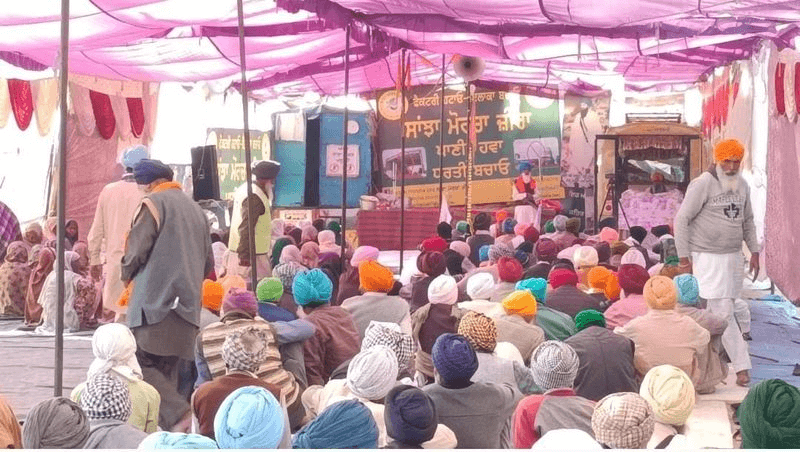Tags
Heart of Punjab: Farm protest exposes industry-farmer chasm.
Rajpura, the first urban centre as one enters Punjab from Haryana’s Ambala, is just a few kilometres from Shambhu, which has remained one of the epicentres of a farmers’ protest for almost a year now. Being the gateway to Punjab,…
Ruchika Khanna, Tribune News Service

Rajpura, the first urban centre as one enters Punjab from Haryana’s Ambala, is just a few kilometres from Shambhu, which has remained one of the epicentres of a farmers’ protest for almost a year now.
Being the gateway to Punjab, and beyond to Jammu and Kashmir, this town is a popular destination for warehousing a number of industrial and fast-moving consumer goods (FMCG) that come from all over the country for consumption in the region.
In the past two months, at least four big companies have shifted their warehouses to Ambala — on the other side of the barricades put up by the Haryana Police to stop the protesting farmers from entering the state.
The town has more than 50 warehouses. Now, warehouse owners complain that companies are forcing them to charge lower rent by threatening to move out to the Ambala side.
Fuel stations, motels, roadside dhabas and tea stalls in and around Rajpura are also grappling with the loss of business because of the long-drawn protest, which started in February last year over the demands, including a central law assuring a minimum support price (MSP) for crops.
Some fuel station owners say their sales have declined by as high as 60%. Had it not been for a cement factory near Shambhu, the fall in sales would have been much higher, said a fuel station owner.
Gurinder Singh Dua, owner of Eagle Motels, says his revenue from the motel business has dropped by 90% after the protest started at Shambhu, while the sales at his petrol pump are down by 50%.
Rajpura has always remained a perfect blend of the old and the new. Old fortresses, dating back to early 16th century when Sher Shah Suri ruled at Delhi, blend perfectly with industrial units and the thriving foodgrain trade.
However, Ramesh Kumar Pahuja, president of Rajpura Beopar Mandal, rues that all economic activity seems to have come to a standstill in the town.“We had approached the local MLA, as well as that of Ambala City, urging them to take up the case of Rajpura’s economic distress with the government, but to little avail,” he says.
In other parts of Punjab, while youngsters continue to be lured to foreign lands, frequent run-ins of traders with farmer unions are impacting industrial investment.
Now, nearly a year after farmers started their protest at the Shambhu border, when several small traders and industrial units have been forced to shut shop, the question is whether the economic sentiment prevailing in the town is in any way representative of a bigger picture in Punjab? Is the growing divide between the trader-industry-service sector on one side, and the agitating farmers on the other, also playing out in the rest of the state?
The Punjab born-and-bred industrialists now prefer to set up their units in areas closer to ports and having cheaper land and lower power tariffs.
A multinational IT company that initially wanted to set up a facility on 50 acres in Mohali now wants to surrender 18 acres allotted to it so as to scale down its intended operations.
Many others, after having signed MoUs for industrial investment, are delaying their projects.
Some of the industry leaders in the past had said that they feel “abandoned” by the state government as it often succumbs to the pressure exerted by farmers due to vote-bank politics.
Meanwhile, Punjab’s Aam Aadmi Party government has claimed to have received over 5,300 investment proposals worth Rs 84,000 crore, which it said will create nearly 3.90 lakh jobs in the state.
While Chief Minister Bhagwant Mann has himself invited big industrialists to invest in the state, Industry Minister Tarunpreet Singh Sond has also been meeting industrial bodies associated with food processing and IT sector, urging them to invest in Punjab.
However, the industry-labour relationship, which remained one of the selling points for Punjab, seems to have now been lost under the noise of frequent farmer protests.
It is perhaps for the first time in Punjab that a sharp division is being seen between farmers and the industry.
Earlier, industrialists used to complain about “over-activism” of farmer unions in a hushed manner. Now, they are openly speaking against the farmers’ stir as the raw material being imported from other parts of the country has become expensive due to a spike in freight costs.
Transporting finished products to outside the state has also become costly as the protesters have blocked the main highway that connects Punjab with other parts of the country.
“The demographic divide between urban and rural areas has always been there in Punjab. Now, it is the occupational divide that is playing out in the state. The services sector, which contributes 46% to the state GDP, and the other industry, want mobility and access. This is being blocked by the protesting farmers. Incidentally, the agriculture sector’s contribution to the state GDP is just 21%,” said Parmod Kumar, a leading social scientist in the region.
“The former two consider themselves as the growth drivers and the protest is being seen as a bid to halt their progress,” he added.
https://www.tribuneindia.com/news/punjab/heart-of-punjab-farm-protest-exposes-industry-farmer-chasm/Published Date: January 20, 2025






